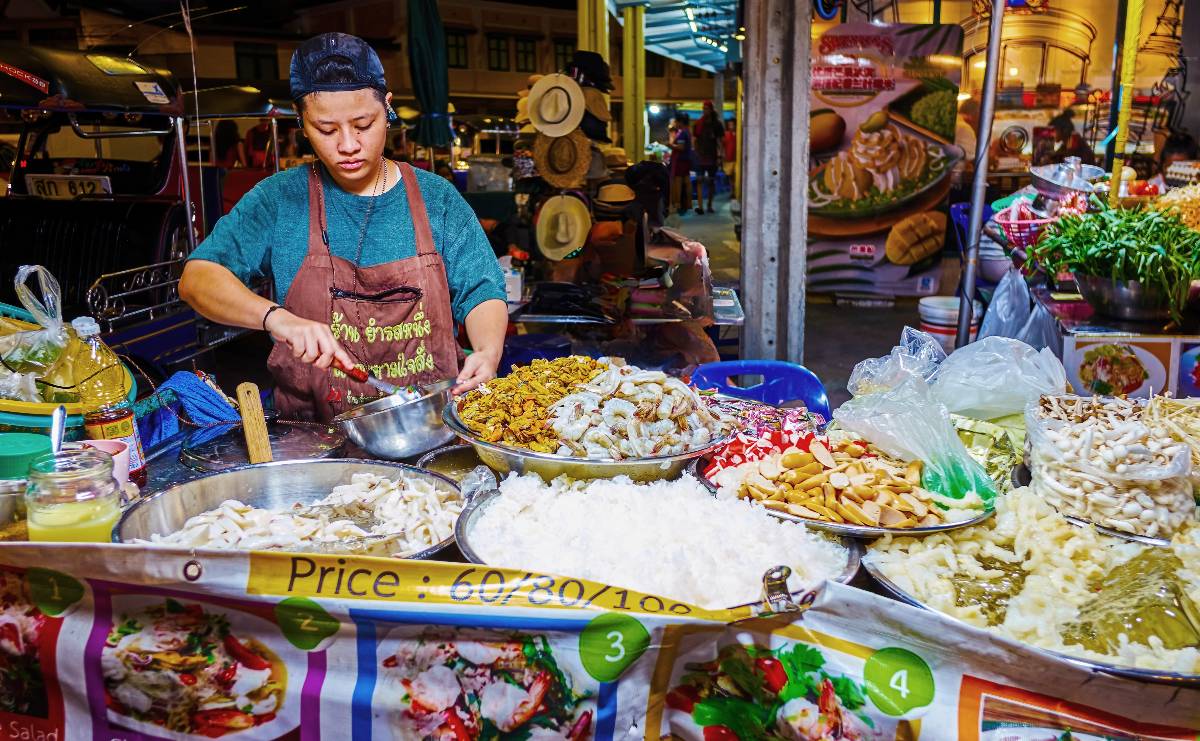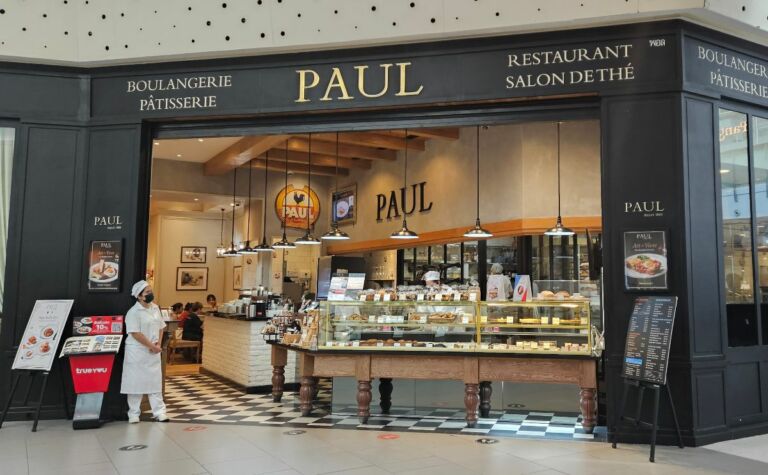Best Street Food in Bangkok: a Journey into Thai Cuisine
When visiting Thailand’s capital, finding the best street food in Bangkok is top of the list for food lovers. Paula and I have been eating street food here for years and together have come up with our favourite places to go.
I’m going to dive into some of the most classic Bangkok street food dishes and where to get them. I’ll present this guide sorted by the dish, how it’s made, and our favourite place to get it.
Are you ready for your culinary adventure?
This page contains affiliate links. Please see our disclosure policy for more details.
Pad Thai
Pad Thai is probably the most well-known street food in Thailand. These fried noodles in a special sauce, most commonly served with shrimp, can be found on many street corners.
It’s not as easy to cook as it appears to be; it can go from being the most delicious thing you’ve ever eaten to something you wouldn’t serve to your worst enemy. It can also range from 40 baht per dish if cooked by a local street vendor to upwards of 300 baht if you order it at a fancy restaurant.
How it’s Made
Classic Pad Thai is thin, flat rice noodles with a sweet-savoury sauce (Tamarind is the main ingredient); it includes bean sprouts, garlic chives and tofu. It’s scattered with crushed peanuts and mainly served with shrimp or chicken. Many westernised versions include soy sauce and lime juice, but that’s not the traditional flavouring.
Where to Get the Best Pad Thai
Ask any tourist operator, and they’ll tell you that Thipsamai has the best Pad Thai in Bangkok. People being prepared to queue up for over an hour to get in will confirm that.
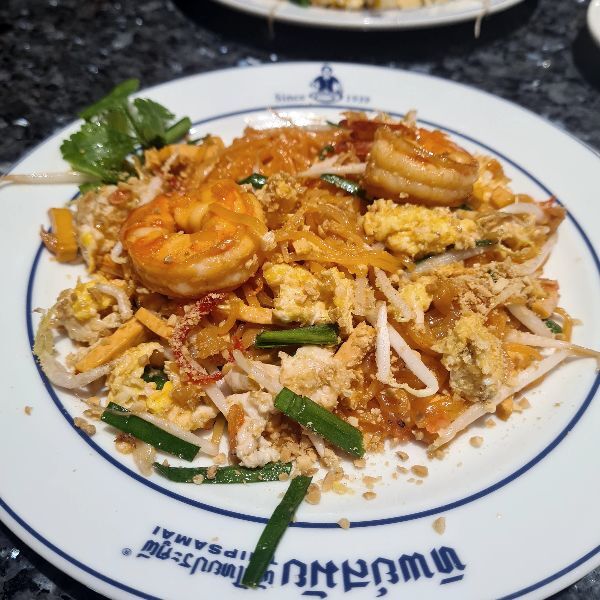
I’ve been there, and the Pad Thai is ok but not the best I’ve had. However, one night, I didn’t want to wait in line and went to the restaurant next door on its left. It was so much better, and no waiting.
I was in Chinatown one night and stumbled upon a small vendor selling Pad Thai on a quiet stretch of Yaowarat road just before you hit the restaurant precinct. It was amazing and only 50 baht.
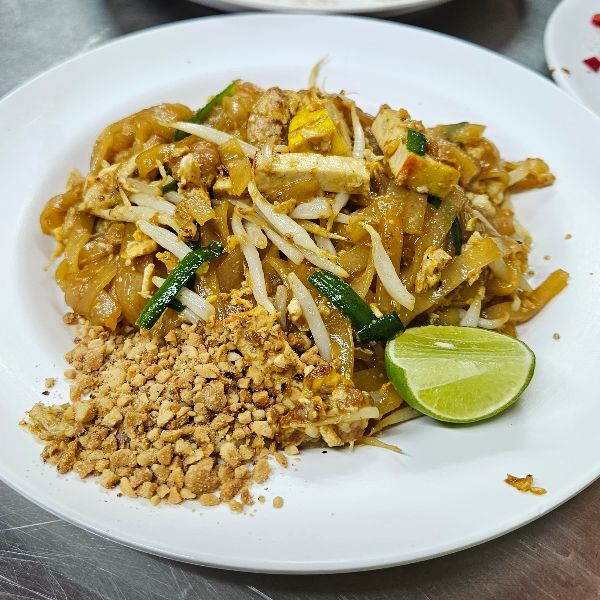
Som Tum (Papaya Salad)
Som Tum is a staple in Thai diets and is almost always one of the dishes served at every mealtime. It’s commonly translated to Papaya Salad, which isn’t technically correct as it comes in versions with corn, green beans or other fruits instead.
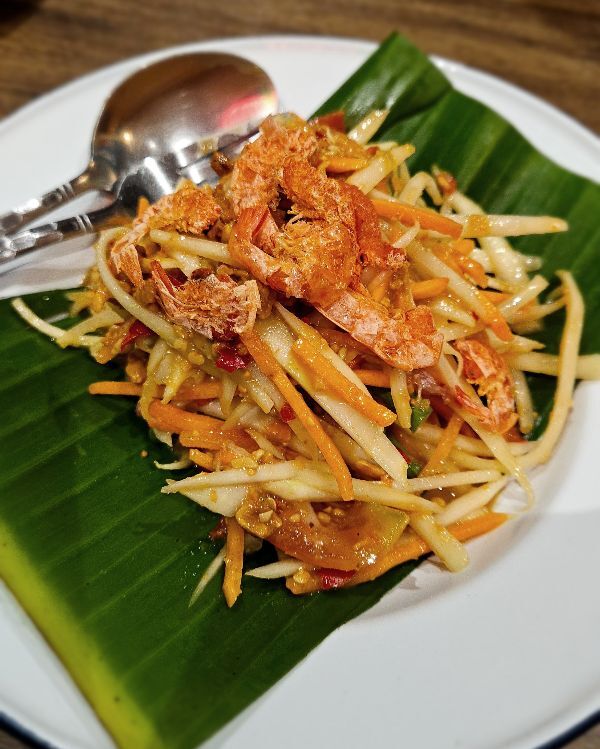
You can get it at every food market, food court and street food corner. I usually find it too spicy for me, even when I ask for ‘Ped Noi’ (a tiny bit spicy). It also ranges in price from 30 baht at a local vendor to over 200 baht in a restaurant. Paula, on the other hand can handle it at the local heat level!
How it’s Made
Green papaya, fiery chilis, tomato, green beans, garlic, palm sugar, fish sauce, tamarind and lime juice are all put in a mortar and pestle and crushed together before being served.
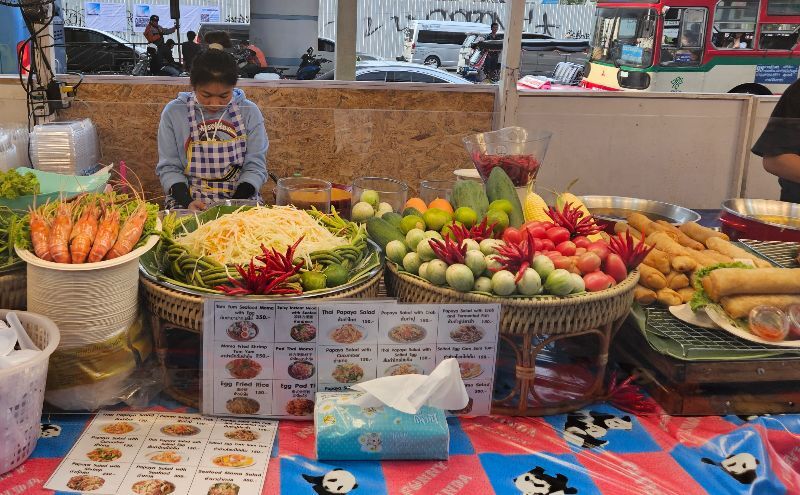
You can choose the chilli level from 1 to 5. As we said, papaya doesn’t need to be the main ingredient. I prefer corn, as it adds more sweetness to the tangy sauce.
Where to Get Som Tum
We both agree that the Silom/Sathorn area has Bangkok’s best Som Tum street vendors. Narrowing it down to just one was hard, but we got there. The winner is Som Tam Jay So. This is Som Tum, Isaan style. It gets really crowded at lunchtime, but it’s worth the wait.
Pad Ka Prao (Stir Fry With Holy Basil)
Commonly known as ‘the food you order when you can’t be bothered making a decision, ‘ pad ka prao is a dish found all over Thailand. This meal can be cooked in less than two minutes, making it perfect when you’re starving and in a hurry, and you can get it everywhere at any time.
How it’s Made
It appears easy to make, but get the combination of sauces incorrect and it doesn’t quite taste right. Garlic and chilli are cooked first, then the protein is added, and the sauce is a mix of oyster, fish, and soy.
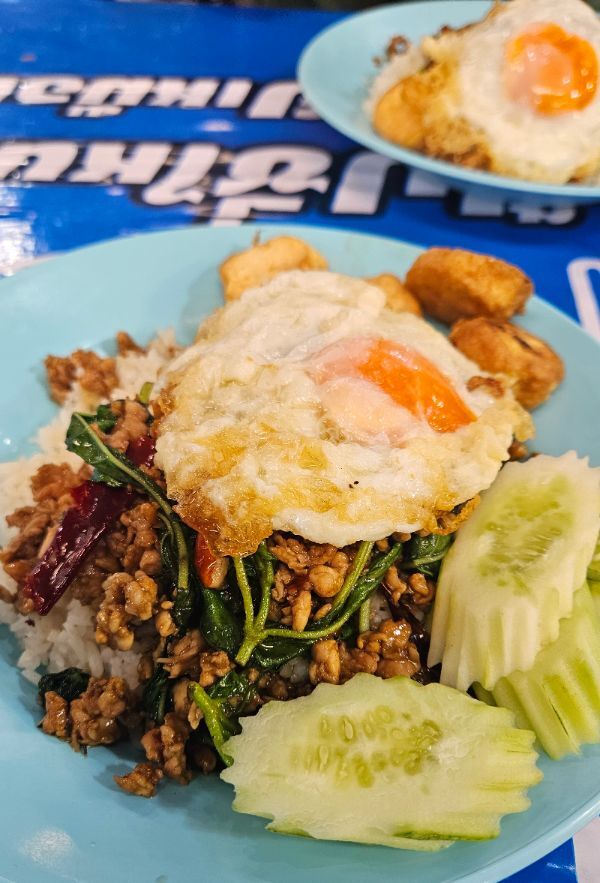
The final touch is the ingredient that gives it its signature flavour: the holy basil leaves. These are tossed in at the end, quickly stirred in, and then taken off the heat.
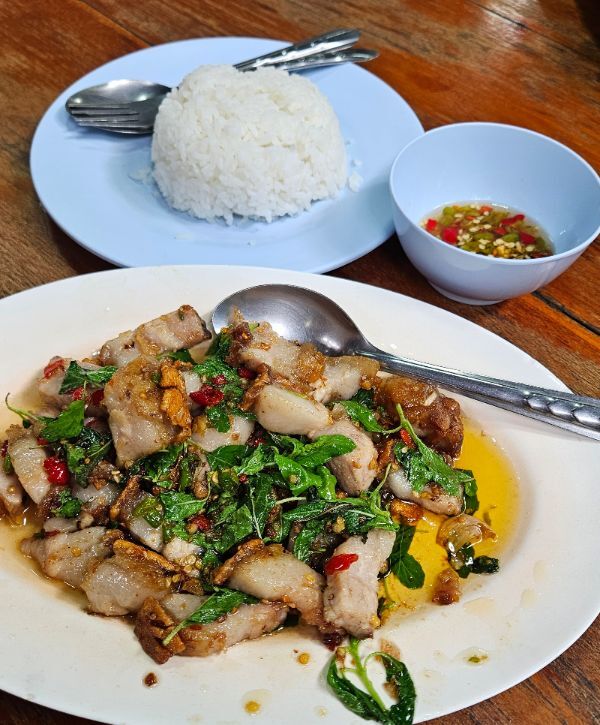
The most common proteins are moo sub (pork mince), gai (chicken), and moo grob (pork belly), but you could add almost anything, and it would work. The best way to eat it is topped with khai dao (fried egg).
Where to Get Pad Ka Prao
Paula is a huge Pad Ka Prao fan and likes hers Thai-style hot. Her favourite place is in Khlong Toei at Ruam Sab Market; she won’t let me eat it anywhere else, and of course, she’s right.
Khao Man Gai (Chicken and Rice)
Don’t disregard this delicious food just because of the simple name. Khao Man Gai is found on street corners all the way up to Michelin-star restaurants. This Thai staple ranges in price from around 50 baht to over 200 baht.
How it’s Made
There are two secrets to Thailand’s version of chicken and rice. For starters, the rice is boiled in chicken stock, ensuring the chicken flavour is present throughout the entire meal.
The way it differs from shop to shop, though, is the dipping sauce. Some serve generic store-bought condiments while others take the time to make their own — they’re the ones who get my business.
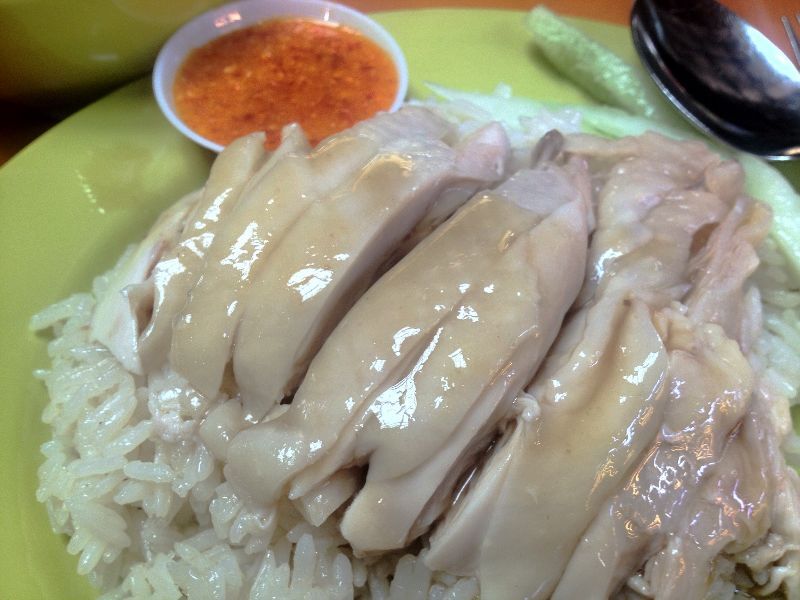
You can get your chicken three ways: steamed (tom), fried (tod), or grilled (yang). Most of the time, I get the tom/tod combination. It’s always served with a clear chicken broth, which is equally as delicious as the meal itself.
Where to Get Khao Man Gai
Forget the overpriced restaurants and delivery service. My favourite Khao Man Gai is served by a street vendor just around the corner from Sam Yod MRT station and not far from the famous Golden Swing.
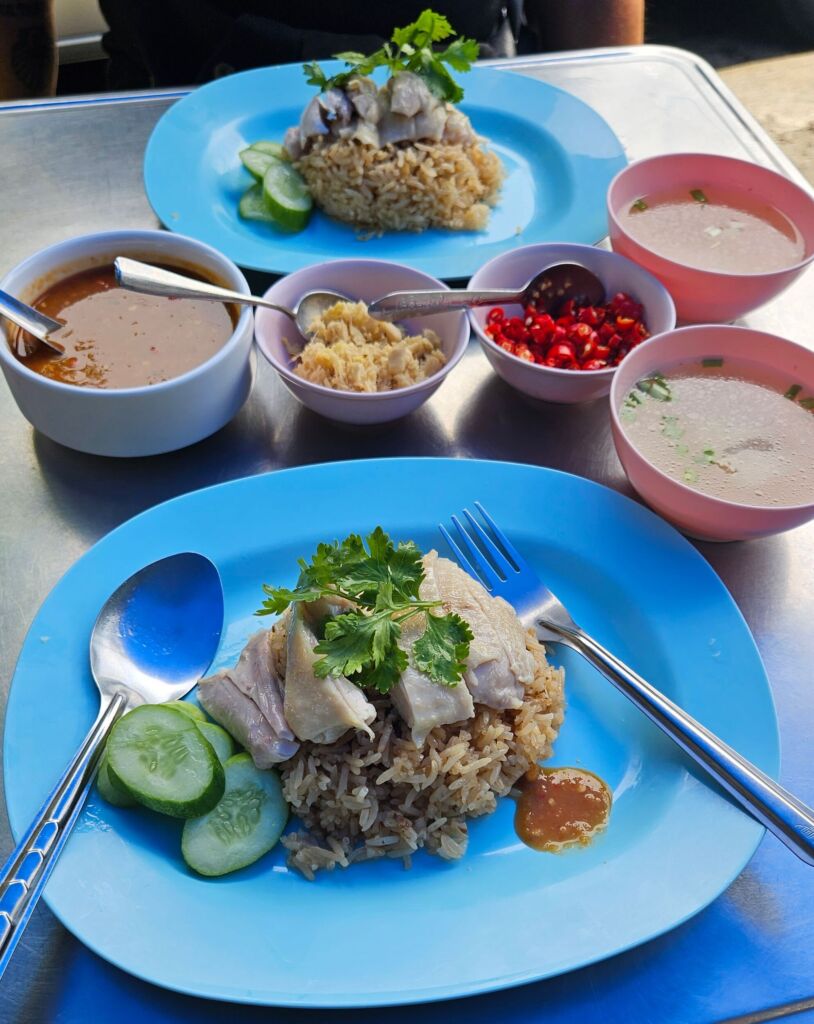
It’s called Jack’s Chicken Rice, and Jack is a lovely man. He cooks it onsite, his grilled version is superb, and I’m a massive fan of his fried chicken. He also makes his own dipping sauce.
Tom Yum Goong (Hot & Sour Soup)
Soups are very common in Thailand, and we could do an entire article on all the different ones, but the two most popular are Tom Yum Goong (Spicy soup with shrimp) and Tom Kha Gai (Chicken soup with coconut milk), featured further down the page.
Tom Yum Goong is Thailand’s unofficial national food. It’s rare to go to lunch or dinner with a group of Thai friends, and this dish doesn’t get ordered.
Tom Yum flavouring is trending in Thailand; you can now get it as a spaghetti sauce, fried rice, or pizza (I love this!).
How it’s Made
This hot and sour soup is made from galangal, kafir lime leaves, and lemongrass. Thai chilli paste and fish sauce are added to the flavour. Goong (shrimp) is the most commonly used protein, but you could substitute chicken or any other seafood.
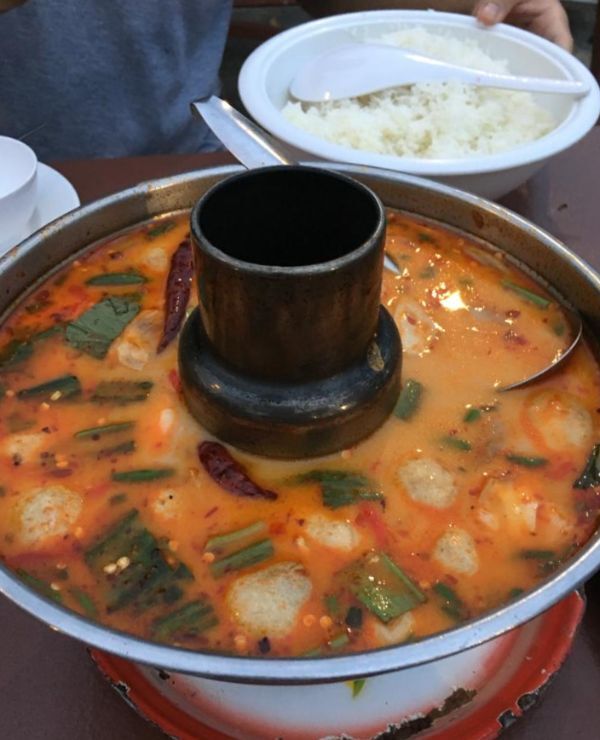
Where to Get Tom Yum Goong
Tom Yum Goong is available in almost every restaurant in Bangkok. I’ve never been told it’s unavailable, even if it’s not on the menu. However, one of the best is found at Bangkok institution Jeh O Chula. This restaurant is so popular that people will queue up for hours to get in. I’ve waited more than an hour before, but the food is so good that I didn’t care. They don’t take reservations, and it really is first-in, first-served.
Pro tip: Jeh O opens at 5 pm, and the queues don’t start until around 6 pm. Early dinner, anyone?
Pad See Ew (Fried Noodles in Soy Sauce)
One of my favourite Thai dishes, and I eat this on a weekly basis, is Pad See Ew. It’s a pleasant change from rice-based meals. I prefer my noodles dry and not in a soup; this is a delicious alternative.
How it’s Made
There’s a fine art to cooking Pad See Ew; it’s cooked in a minimal amount of oil, and if it’s not done correctly, it has a burnt taste, something I found in many Thai Restaurants outside of Thailand.
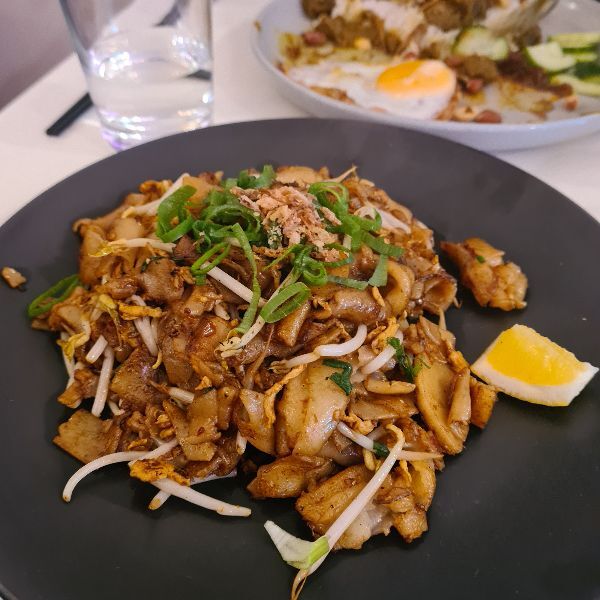
The traditional Pad See Ew is made with moo (pork), and some shops will only sell it that way. Chicken (gai) and sometimes fish (pla) are used instead. You could always try your luck and order an alternate protein, but be prepared to be told no if they’re a traditionalist.
Where to Get Pad See Ew
I’ve tried Pad Thai in over 30 provinces of Thailand, and my favourite isn’t found at a place you’d expect. It’s actually served in a bar in Silom Soi 4 called Connections. The bar owner’s sister is from the Isaan area of Thailand, and her food is very traditional. Her Pad See Ew is the best, by far. Because of regulations, the bar only opens at 5 pm, so it’s a dinner option only, but totally worth the wait.
Pla Tod (Fried Fish)
My absolute favourite Thai food, which I eat more than once a week, is Pla Tod (fried fish). There’s such pleasure in breaking off chunks of fish that are crispy on the outside and soft and fluffy on the inside. While it’s a popular choice for street vendors by the sea, you can get in widely across Thailand, including Bangkok.
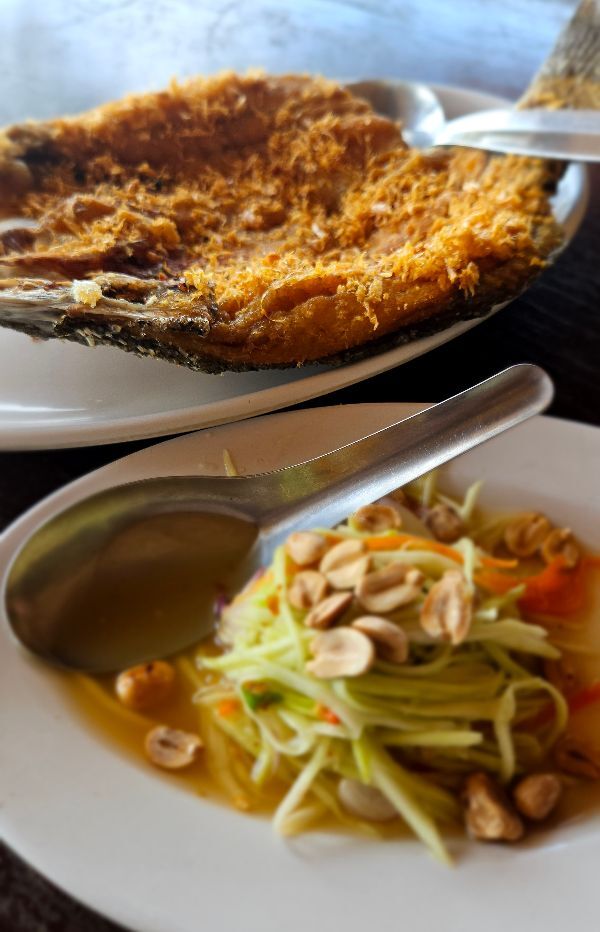
How it’s Made
A whole fish (sea bass is the most commonly used) is thrown into a pan of hot bubbling oil and fried until it comes out crisp but never burnt. It’s served with a dipping sauce that’s usually citrus-based. It’s most often served with steamed rice.
Where to Get Pla Tod
Ok, so I’m going to cheat here. My favourite restaurant serving pla tod is just outside Bangkok in the Nonthaburi province. It’s found at No Khu (Owl) market next to the Yaek 1 MRT station. The serving is always huge; the staff are incredibly attentive, and the best part is it’s only 159 baht compared to upwards of 400 baht everywhere else.
Tom Kha Gai (Thai Coconut Soup)
Our second featured soup is Tom Kha Gai (Chicken soup with coconut milk); this delicious creamy soup is sweeter than Tom Yum Goong and is more aromatic than spicy. This soup is an excellent choice for gluten-intolerant people as there is no rice or noodles in the dish.
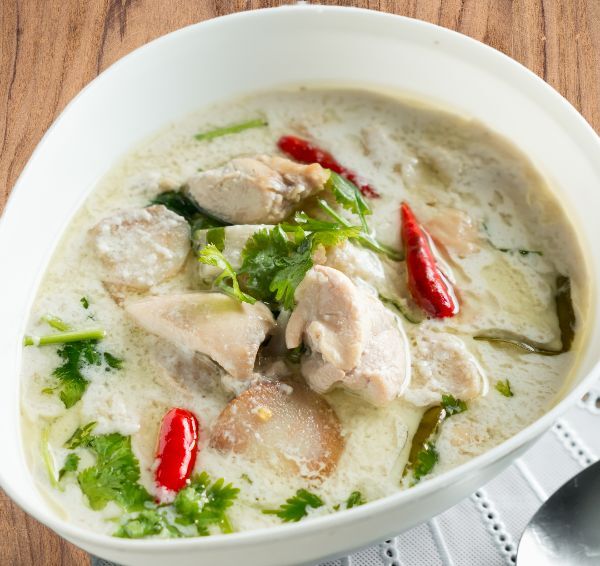
How it’s Made
Coconut milk and chicken are the core ingredients, and the fragrance comes from galangal, lemongrass, and lime leaves. You could substitute fish for chicken, but I wouldn’t eat this with any red meat or crustaceans, as the flavours wouldn’t go well together. This soup is a labour of love, taking a good 30 minutes to perfect. It’s great made in advance and heated up the next day; the longer it’s left, the stronger the flavours grow.
Where to Get Tom Kha Gai
Tom Kha Gai is one of my favourite Thai dishes, and I order it everywhere I go. It’s hard to get it wrong, and it’s delicious everywhere. But my favourite venue is Madam Musur, which is just off Khao San Road. The service is exceptional, and you can sit at a table on the footpath and people-watch as you eat.
Frequently asked questions about street food in Bangkok
It can be daunting to eat street food for the first time if you are travelling from a western country. These are some of the most common questions we have been asked.
is it safe to eat street food in bangkok?
Is Bangkok street food safe? That’s a question on the minds of many travellers. Well, yes, and no. Like anywhere else, food safety can vary from stall to stall. However, with a few practical tips, you can safely dive into the delectable delights that Bangkok’s street food scene has to offer.
Choosing the Right Stall
First, select a busy stall — a high turnover of ingredients is a good indication of fresh food. See where the locals are eating; their knowledge is invaluable. If a stall is popular with Bangkok residents, chances are the food is delicious and safe to eat.
Watch the Preparation
Observing the preparation process can offer you important insights. Look for signs of good hygiene practices, like the use of gloves or regular handwashing. Ensure that food is thoroughly cooked and served hot.
Follow Your Gut
Lastly, trust your instincts. When it comes to food, your nose and eyes are powerful tools. Does the food smell good? Does it look fresh? If something doesn’t seem right, it’s better to move to the next stall.
Armed with these tips, you should be able to navigate through Bangkok’s bustling street food scene with ease, confidence, and an eager palate.
Note: Be aware that many Western travellers may experience a mild upset stomach in the first few days as they adjust to locally different bacteria – this is completely normal and should not be confused with food-borne illness.
What is the best time of day to visit the street food markets in Bangkok?
Timing is everything, and with the bustling street food scene of Bangkok, this is even more vital. While you can find stalls that serve throughout the day, the food market culture truly comes alive during certain times.
Early Morning
If you’re an early riser, you’re in luck. Many Bangkok street vendors start their day bright and early, around 6:00 AM.
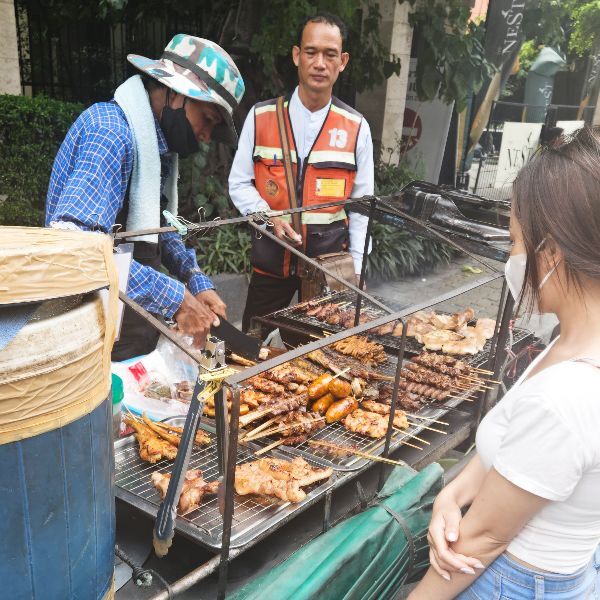
It’s a fantastic time to try delicious breakfast options like khao neow moo ping (grilled pork skewer with sticky rice), or fresh fruits. You’ll find the streets less crowded in the early hours, creating a tranquil food experience as the city awakens.
I also love the fruit sellers who pop up by mid morning perfectly timed for a snack
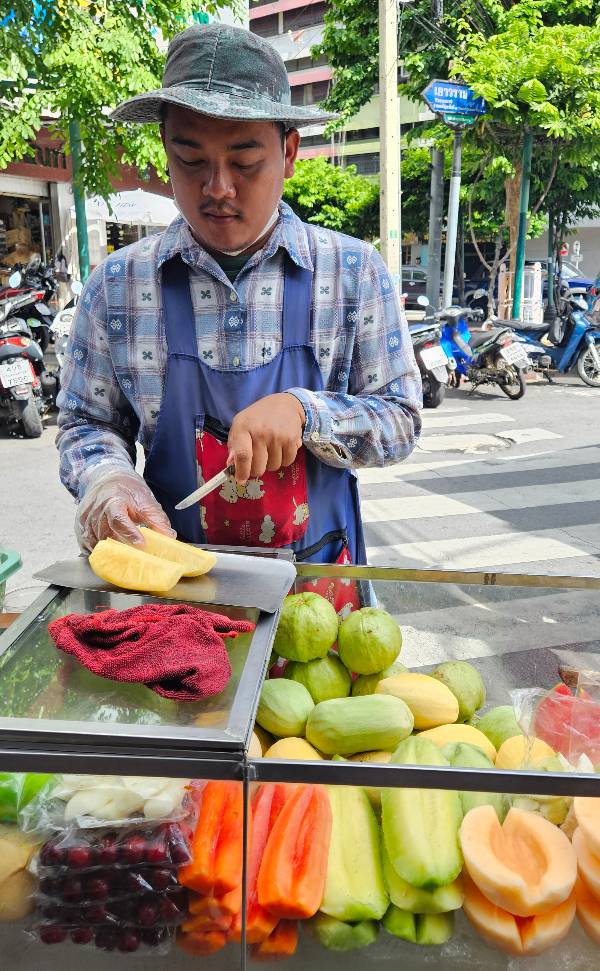
Lunch Time
By lunchtime, the streets buzz with a different energy. Schools and businesses are out for a meal break, and the food carts become the city’s heartbeat. This time around, you can dig into more substantial dishes like Pad Thai or Som Tum. Do remember, it can get pretty busy at this time of the day.
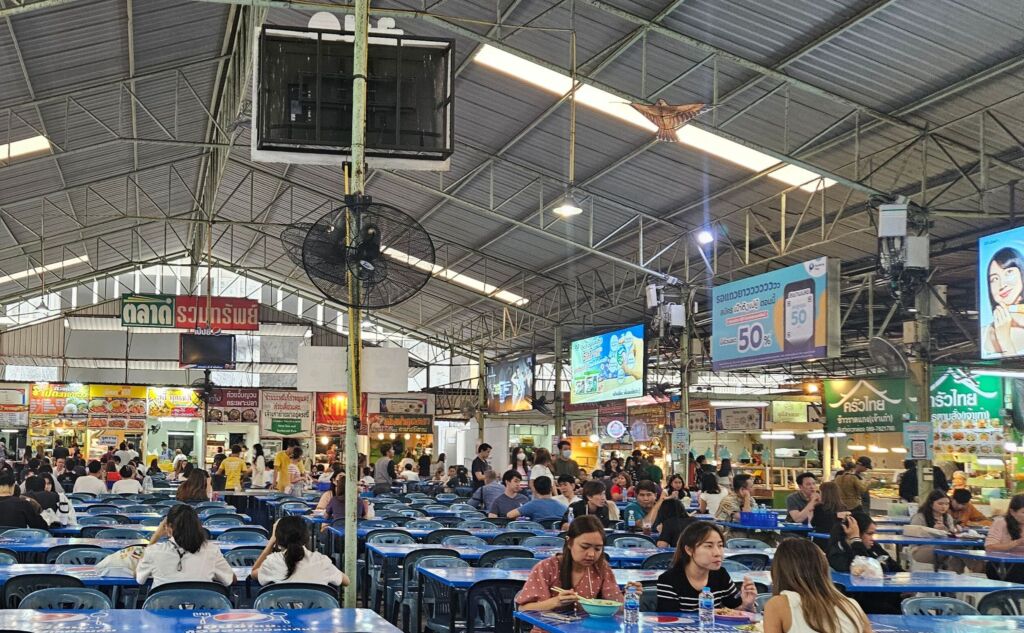
In areas with lots of office workers you will find indoor food centres that cater especially to them like this one near Asok MRT called Ruam Sab Market. There are also several great ones in Silom.
Evening and Night
However, the real spectacle unfolds after the sunset — most Thai street food markets completely transform into vibrant night markets offering an extraordinary mix of tastes and aromas. From 6:00 PM onwards, Bangkok’s street food scene becomes a gastronomic paradise, attracting hordes of locals and tourists alike. Most well-known dishes like Pad See Ew, Pla Tod, and the sweets stalls bustle to cater to the food frenzy of the crowd.
Tip: With the humidity and tropical heat of Bangkok, evenings can be the most comfortable time to explore, offering not only a refreshing temperature but also a unique perspective on local nightlife culture.
Many vendors keep serving until the early hours of the morning — so night owls can still catch a tasty bite even after a late-night outing. From noodles soups to barbecue skewers and even dessert, Bangkok’s street food culture does not sleep.
Are there any street food tours or guided experiences available in Bangkok?
If the thought of navigating the bustling, vibrant food scene of Bangkok alone is a tad overwhelming, there are plenty of guided food tours to handhold you.
One of the best things about joining these tours is that you will taste things you may not have been adventurous enough to order alone and you will more than likely discover lots of wonderful flavours that become new favourites.
A Chefs Tour
Paula recently took a food tour with A Chef’s Tour.
“The best good tours I have ever done anywhere on my travels have been those offered by A Chefs Tour. I have taken their tours in Phuket and Chiang Mai and earlier this year joined the Chinatown tour.
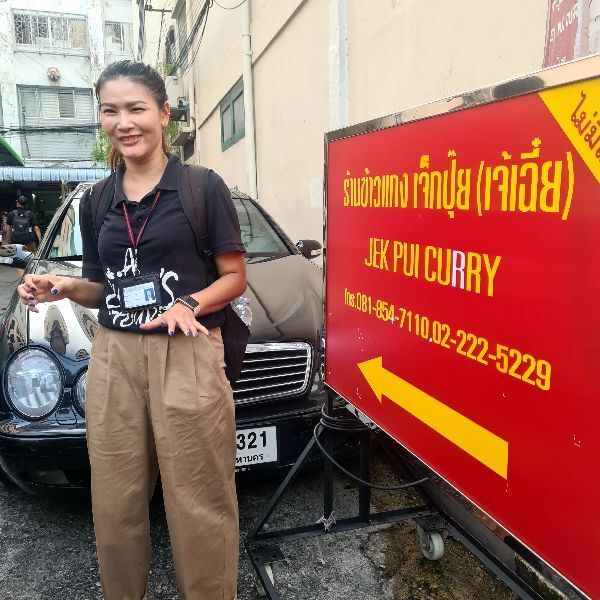
If you are keen to have an incredible experience in Bangkok’s Chinatown this is it. As one of the city’s oldest districts, Chinatown is known for its incredible range of street food. Taking you through narrow alleyways and lively food stalls, this tour provides a unique insight into the heart and soul of Bangkok’s culinary scene.
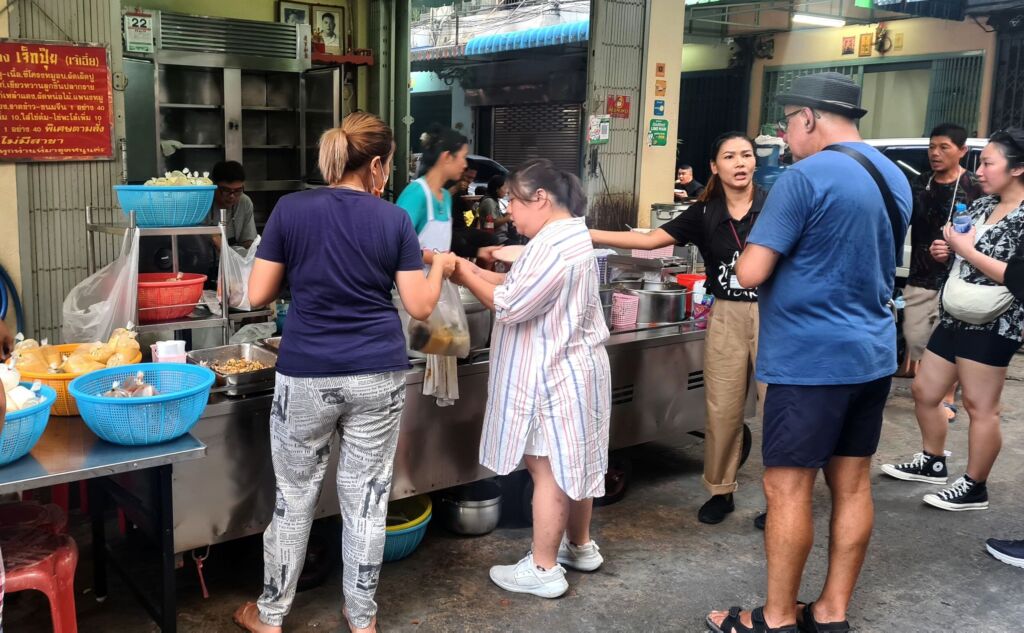
What I love about this Chinatown food tour is that it doesn’t just give you a taste of the thriving Bangkok food culture – it also immerses you in the local community. The tour guides make a point of fostering connections with the street vendors, supporting them directly and offering you the chance to engage with them on a personal level, making your culinary adventure a cultural one as well.
I think A Chefs Tour of Bangkok’s Chinatown is a must for anyone with a curious palate and an adventurous heart, and a big appetite!’
Hungry Yet?
Now that Paula and I have taken you on a street food culinary adventure, the only question left is, what do you try first?
Pad Thai and Pad See Ew are your noodle options. If soups are your favourite, Tom Yum Goong and Tom Kha Gai will satisfy you.
A trip to Thailand is incomplete unless you’ve tried Pad Ka Prao, Khao Man Gai, and Som Tum, and if you love fish as much as I do, you’ll think Pla Tod is the best thing you’ve ever eaten.
Ready to start planning your Thailand trip? Our Facebook community Thailand Awaits is here to help. Join fellow travellers, get your questions answered by Thailand experts, and access free planning resources.

